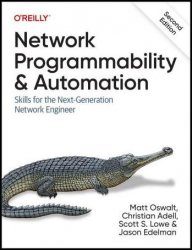Network Programmability and Automation: Skills for the Next-Generation Network Engineer, 2nd Edition (Final)
- Добавил: literator
- Дата: 24-08-2023, 19:48
- Комментариев: 0
 Название: Network Programmability and Automation: Skills for the Next-Generation Network Engineer, 2nd Edition (Final)
Название: Network Programmability and Automation: Skills for the Next-Generation Network Engineer, 2nd Edition (Final)Автор: Matt Oswalt, Christian Adell, Scott S. Lowe, Jason Edelman
Издательство: O’Reilly Media, Inc.
Год: 2023
Страниц: 825
Язык: английский
Формат: epub (true)
Размер: 10.1 MB
Network engineers are finding it harder than ever to rely solely on manual processes to get their jobs done. New protocols, technologies, delivery models, and the need for businesses to become more agile and flexible have made network automation essential. The updated second edition of this practical guide shows network engineers how to use a range of technologies and tools, including Linux, Python, APIs, and Git, to automate systems through code. This edition also includes brand new topics such as network development environments, cloud, programming with Go, and a reference network automation architecture.
Network Programmability and Automation will help you automate tasks involved in configuring, managing, and operating network equipment, topologies, services, and connectivity. Through the course of the book, you'll learn the basic skills and tools you need to make this critical transition.
Should Network Engineers Learn to Code? Unfortunately, you aren’t getting a definitive yes or no from us. Clearly, we have a full chapter on Python and another on Go, and plenty of examples throughout the book on how to use Python or Go to communicate to network devices via network APIs and extend DevOps tools like Ansible and Terraform, so we definitely think learning the basics of any programming language is valuable. We also think it’ll become an even more valuable skill as the network and IT industries continue to transform at such a rapid pace, and we happen to think Python is a pretty great first choice.
We consider Python a great first choice when it comes to network automation for several reasons. First, Python is a dynamically typed language that allows you to create and use Python objects (such as variables and functions) where and when needed, meaning they don’t need to be defined before you start using them. This simplifies getting started. Second, Python is also super readable. It’s common to see conditional statements like if device in device_list:, and in that statement, you can easily decipher that we are simply checking to see if a device is in a particular list of devices. Another reason is that network vendors and open source projects are building a great set of libraries and tools using Python. This just adds to the benefit of learning to program with Python.
You'll learn:
• Programming skills with Python and Go: data types, conditionals, loops, functions, and more
• How to work with Linux-based systems, the foundation for modern networking and cloud platforms
• Data formats and models: JSON, XML, YAML, and YANG
• Jinja templating for creating network device configurations
• The role of application programming interfaces (APIs) in network automation
• Source control with Git to manage code changes during the automation process
• Cloud-native technologies like Docker and Kubernetes
• How to automate network devices and services using Ansible, Salt, and Terraform
• Tools and technologies for developing and continuously integrating network automation
Contents:
Скачать Network Programmability and Automation: Skills for the Next-Generation Network Engineer, 2nd Edition (Final)
Внимание
Уважаемый посетитель, Вы зашли на сайт как незарегистрированный пользователь.
Мы рекомендуем Вам зарегистрироваться либо войти на сайт под своим именем.
Уважаемый посетитель, Вы зашли на сайт как незарегистрированный пользователь.
Мы рекомендуем Вам зарегистрироваться либо войти на сайт под своим именем.
Информация
Посетители, находящиеся в группе Гости, не могут оставлять комментарии к данной публикации.
Посетители, находящиеся в группе Гости, не могут оставлять комментарии к данной публикации.

